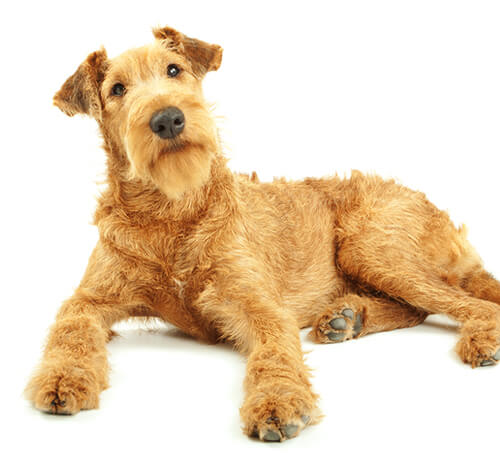
Irish Terrier
Originally bred to kill vermin on farms, the Irish Terrier is distinguished by his solid red, dense, low-shedding coat and long, tall body. Courageous, loyal and lively, this breed is affectionate with his human companions but aggressive toward other dogs. The athletic Irish Terrier requires regular exercise in a fenced yard and several leashed walks per day.
DID YOU KNOW? One of the oldest terrier breeds, the Irish Terrier is a descendant of the ancient wirehaired black-and-tan terrier of Great Britain and the Irish Wolfhound. The Irish Terrier was recognized as a separate breed in 1875 in Glasgow, Scotland. The Irish Terrier was used as a messenger and sentinel during World War I.
ALSO KNOWN AS: Irish Red Terrier
The need-to-know
- Dog suitable for owners with some experience
- Some training requiredEnjoys active walks
- Enjoys walking an hour a day
- Medium dog
- Minimum drool
- Requires grooming every other day
- Non hypoallergenic breed
- Chatty and vocal dog
- Guard dog. Barks and alerts
- May require training to live with other pets
- May require training to live with kids
Personality

Despite their nickname - the ‘Red Devil’ - the Irish Terrier is a good-tempered, fun and devoted companion who are affectionate and highly bonded to their owners. They can however also be reckless and mischievous, are totally fearless, and have a reputation for being feisty with other dogs on occasion and may not be safe with cats or small furries.
History and Origins

Country of Origin: Ireland
The Irish Terrier is the oldest of the four Irish terrier breeds and was used as a watchdog and for pest control in the Cork area. They would happily take on everything from rats to badgers. They appealed to all walks of life and were kept by both commoners and nobility. Once known as the Irish Red Terrier, to avoid confusion between other Irish terrier breeds, this dog was also known as the Red Devil and was used as a messenger dog in the First World War where their bravery and tenacity became legendary. The breed’s exact origins are not known, but probably developed from the old black and tan terrier crossed with other local dogs.
Nutrition and Feeding

The Irish Terrier needs to have a balanced diet including all the main nutrient groups and a constant supply of fresh water. It's also important to conduct regular body condition scores to ensure you keep your dog in ideal shape and remember to feed him at least twice daily and in accordance with the feeding guidelines of his particular food.
Exercise

Irish Terriers need at least an hour of dog exercise each day - along with plenty of games with their owner and enrichment toys (which should ideally include a chance to dig and some scent work). This is a breed that needs to be able to explore the sights and scents of the countryside but as they may not always be good with unknown dogs, it is good to have access to open, dog-free areas where they can be let off the lead.
Other Information

Health and Common Concerns
Irish Terrier dogs are generally robust, healthy dogs. They do have a recognised hereditary condition called hyperkeratosis, where the footpads crack, however careful breeding means that this is now rare.
Space Requirements
The Irish Terrier is a dog who can live in a small home and garden as long as they have access to good rural or open areas for exercise.
Training Irish Terriers
When it comes to dog training, the Irish Terrier is a clever dog who enjoys working with their owners and can be trained to quite a high standard - as long as they can be kept motivated and enthused using positive, reward-based methods. Dog socialisation should be early and ongoing to overcome any argumentativeness with other dogs, and a good recall should be prioritised. Neither of these should entirely be relied upon in the great outdoors however!
Best Family Dog Breeds
Like many terrier dog breeds, the Irish Terrier can lack patience with children - especially if overhandled or grabbed. They can however make good family dog where there are older, dog-aware children. While many dogs are traditionally thought of as being good with children, all dogs and children need to be taught to get on with each other and be safe together. Even so, dogs and young children should never be left alone together and adults should supervise all interactions between them.
Did You Know?
The bravery and tenacity of the Irish Terrier is legendary - and hunters in Africa were known to take Irish Terriers out lion hunting with them!